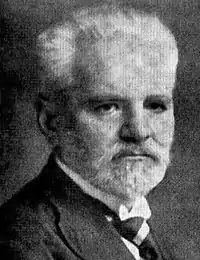Dmytro Antonovych
Dmytro Antonovych (14 November 1877, in Kyiv – 12 October 1945, in Prague) was a Ukrainian politician and art historian.
Dmytro Antonovych Дмитро Антонович | |
|---|---|
 | |
| Secretary/Minister of Naval Affairs | |
| In office January 6, 1918 – February 9, 1918 | |
| Prime Minister | Volodymyr Vynnychenko Vsevolod Holubovych |
| Preceded by | position created |
| Succeeded by | position disbanded |
| Minister of Arts | |
| In office December 26, 1918 – February 13, 1919 | |
| Prime Minister | Volodymyr Chekhivsky |
| Preceded by | position created |
| Succeeded by | position disbanded |
| Personal details | |
| Born | November 14, 1877 Kyiv, Russian Empire |
| Died | October 12, 1945 (aged 67) Prague, Czechoslovakia |
| Political party | RUP, USDRP |
| Spouse | Kateryna Antonovych (nee Serebriakova) |
| Children | Marko Antonovych Mykhailo Antonovych Maryna Rudnytska |
| Occupation | historian, politician, diplomat |
| Signature | |
Family
Professor Dmytro Antonovych was the son of two Ukrainian historians: his father was Volodymyr Antonovych and his mother was Kateryna Antonovych-Melnyk (1859–1942), an archaeologist from the city of Khorol (today – Poltava Oblast). He married the artist and art historian Kateryna Antonovych, and was the father of Marko Antonovych and Mykhailo Antonovych.
Career
In 1900–1905, he was one of the founders and leaders of the Revolutionary Ukrainian Party (RUP), established in 1900 in the city of Kharkiv, and from 1905, of the Ukrainian Social Democratic Workers' Party (USDRP).[1]
Antonovych was a member of the Ukrainian Central Council, and he served as the minister of naval affairs of the Ukrainian People's Republic, in cabinets headed by Volodymyr Vynnychenko and Vsevolod Holubovych (1917-1918), and the minister of arts in Volodymyr Chekhivsky’s government (1918/1919).[2] Then Antonovych was the president of the Ukrainian diplomatic mission of the UNR in Rome.
His works include Estetychne vykhovannia Shevchenka (Shevchenko's Aesthetic Education, 1914), Ukraïns'ke mystetstvo (Ukrainian Art, 1923), Trysta rokiv ukraïns'koho teatru (1619–1919) (Three Hundred Years of Ukrainian Theater [1619–1919], 1925), T. Shevchenko iak maliar (T. Shevchenko, the Artist, 1937), and Deutsche Einflüsse auf die ukrainische Kunst (1942).[3]
References
- Encyclopedia of Ukraine: Antonovych, Dmytro
- Council of National Ministers of the Ukrainian National Republic
- "Antonovych, Dmytro". www.encyclopediaofukraine.com. Retrieved 2023-07-24.